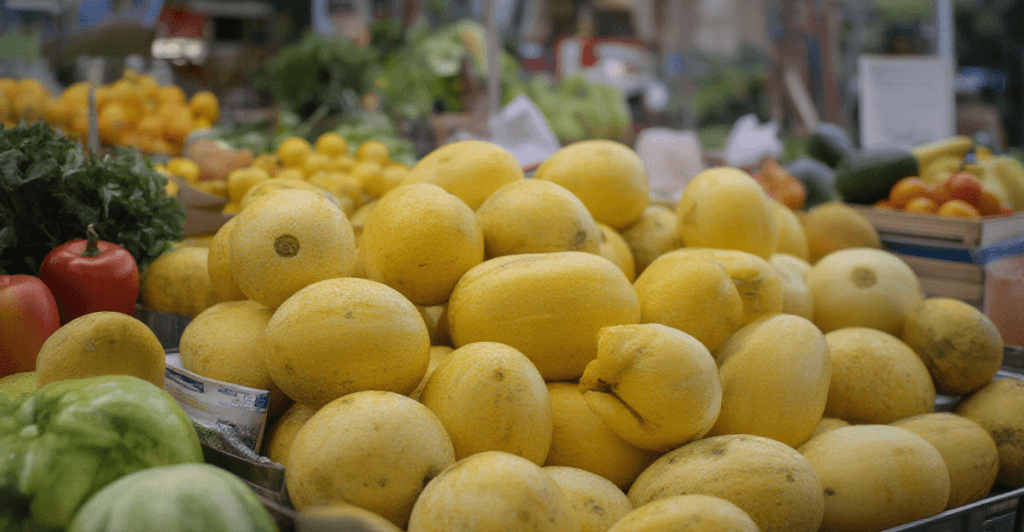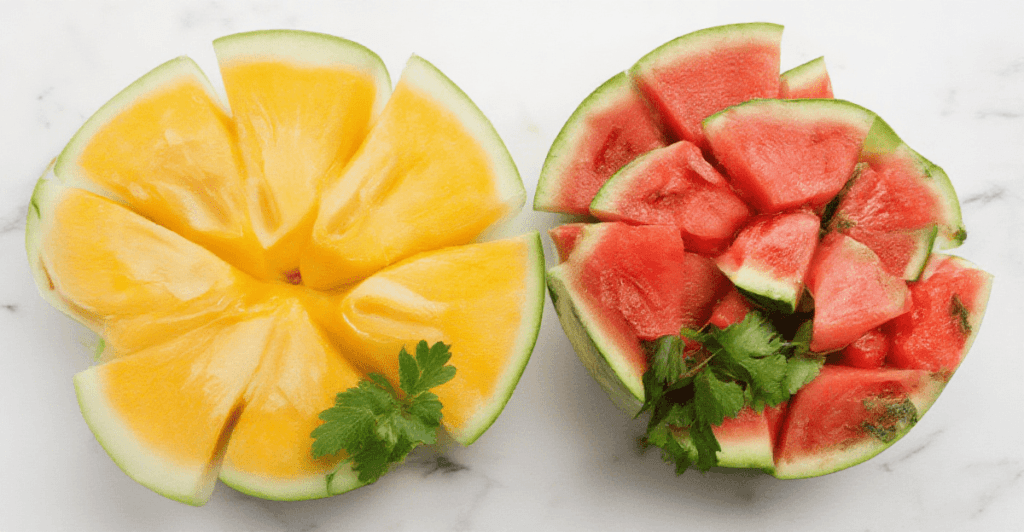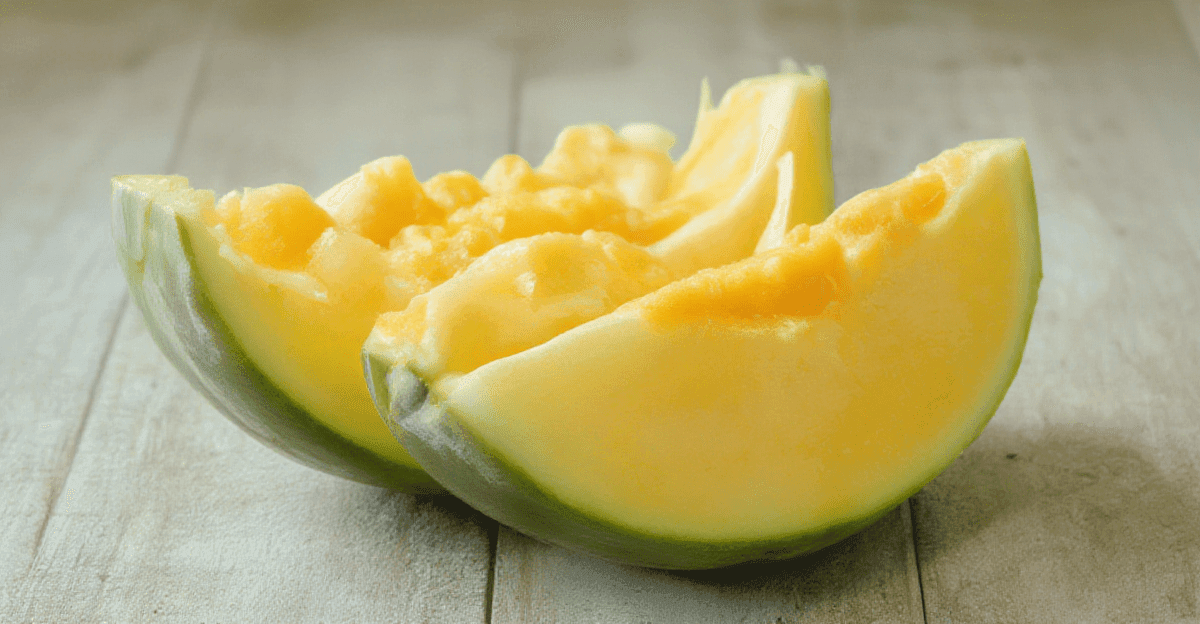INTRODUCTION
Watermelons are a refreshing and beloved summer fruit, but did you know that not all watermelons are red inside? Yellow watermelons are a rare and fascinating variety that intrigues fruit lovers around the world. While not as widely known as the traditional red watermelon, these golden-hued melons offer a unique taste, vibrant appearance, and impressive nutritional value.
In this article, we’ll explore everything you need to know about yellow watermelons: why they exist, how rare a yellow watermelon is, where you can find them, and how they compare to the traditional red varieties. If you’ve ever wondered whether yellow watermelons are natural or why they aren’t as commonly seen in stores, read on to discover the secrets of this unique and fascinating fruit.
What is a Yellow Watermelon?
Yellow watermelons might look like regular watermelons on the outside, but when you slice them open, their flesh is bright yellow instead of red. This color difference surprises many people, but it’s completely natural. Yellow watermelons have been grown for thousands of years, even before red watermelons became popular.
Origins and Unique Characteristics
Yellow watermelons come from the same family as red watermelons, but they have a different pigment that makes their flesh yellow. Unlike the red ones, which get their color from lycopene, yellow watermelons get their color from beta-carotene. This is the same nutrient that gives carrots and pumpkins their orange hue.
What’s even more fascinating is that yellow watermelons were actually the original watermelons! How rare is a yellow watermelon? While they are less common than red varieties, they are steadily gaining popularity. Thousands of years ago in Africa, the first watermelons had yellow or pale green flesh. Over time, farmers selectively bred them to create the red watermelon varieties we enjoy today.
Nutritional Value of Yellow Watermelons
Yellow watermelons are not just pretty to look at—they are also packed with nutrients. They are low in calories and rich in vitamins like A and C, which help keep your skin healthy and boost your immune system. Yellow watermelons also contain beta-carotene, which is good for your eyes and overall health.
Here’s a quick look at the benefits:
- Hydration: Like red watermelons, yellow ones are over 90% water, making them a perfect snack for hot days.
- Rich in antioxidants: Beta-carotene and vitamin C fight off harmful molecules in your body.
- Low in calories: A healthy and guilt-free treat for any time of the day.
How Rare is a Yellow Watermelon?

Yellow watermelons are much rarer than red watermelons, and you don’t see them often in regular grocery stores. But why is that? Let’s explore where they are grown and how often they are available.
Regions Where Yellow Watermelons Are Grown
Yellow watermelons are grown in specific regions around the world. Some of the main places include:
- Africa: This is where watermelons originally came from, including the yellow varieties.
- Asia: Countries like Japan and China grow yellow watermelons for local markets.
- United States: Farmers in certain states like California and Texas grow yellow watermelons, but not as much as the red ones.
These regions have the ideal climate and soil conditions to grow these unique watermelons. How rare is a yellow watermelon? While they are less common than red watermelons, they are still cultivated in smaller quantities. This is because the demand for red watermelons is much higher, leading farmers to grow fewer yellow ones.
Seasonal Availability and Production Levels
Yellow watermelons are usually harvested during the same season as red watermelons, which is late spring to summer. But since they are grown in smaller amounts, they are harder to find. You’re more likely to see them at farmers’ markets or specialty fruit stores than in large supermarkets.
If you’re lucky, you might spot one during peak watermelon season. Keep an eye out for watermelons labeled as “yellow-flesh” or “golden watermelons.”
Why are Yellow Watermelons Rare?
Yellow watermelons are not as common as red watermelons, and there are a few reasons for this. How rare is a yellow watermelon? While they are natural and have existed for thousands of years, they remain less familiar to most people compared to the popular red varieties. Let’s explore why yellow watermelons are harder to find.
Genetic Factors Behind the Yellow Flesh
The bright yellow color of yellow watermelons comes from a natural pigment called beta-carotene. This is the same nutrient that makes carrots and pumpkins orange. Yellow watermelons don’t produce as much lycopene, which is the red pigment in regular watermelons.
In the past, farmers chose to grow red watermelons more often because people liked their bright red color. Over time, red watermelons became the most popular type, while yellow watermelons became less common. Even though yellow watermelons are completely natural, they are now grown on a much smaller scale.
Market Demand and Farming Challenges
Another reason yellow watermelons are rare is because fewer people know about them. Most people expect watermelons to be red inside, so they don’t think to ask for yellow ones. Because there is less demand for yellow watermelons, farmers don’t grow them as much.
In addition, yellow watermelons can sometimes be harder to grow. They need specific conditions, like the right temperature and good soil, to thrive. Since farmers can sell red watermelons more easily, they choose to focus on growing those instead.
However, as more people discover yellow watermelons, their popularity is beginning to rise. How rare is a yellow watermelon? While they are still less common than red varieties, you may start seeing them more frequently in specialty stores or local farmers’ markets in the future.
Difference Between Yellow and Red Watermelons
At first glance, yellow and red watermelons look almost the same on the outside. They both have green rinds with light stripes. But when you cut them open, the difference is clear. Here’s how yellow watermelons and red watermelons compare.
Taste, Texture, and Appearance
- Taste: Yellow watermelons tend to be sweeter than red watermelons. They have a honey-like flavor that many people enjoy. Red watermelons, on the other hand, have a more classic and refreshing sweetness.
- Texture: Both yellow and red watermelons have a juicy and crunchy texture, but some people say yellow watermelons are a bit firmer.
- Appearance: While red watermelons have bright red flesh, yellow watermelons have a golden-yellow color that looks unique and eye-catching.
Differences in Cultivation and Harvesting
Growing yellow watermelons is much like growing red watermelons, but there are a few key differences. How rare is a yellow watermelon? They are less common because they require careful cultivation, and they may take slightly longer to ripen, needing extra attention during their growing season.
Farmers also need to keep yellow watermelon seeds separate from red ones to avoid cross-pollination. This requires extra effort, which is another reason why yellow watermelons are not grown as much.
Overall, both types of watermelons are delicious and healthy. If you’ve only tried red watermelons before, tasting a yellow watermelon can be a fun and surprising experience.
Health Benefits of Yellow Watermelons
Yellow watermelons are not just rare and tasty—they’re also very good for your health. Like red watermelons, they are full of water and important nutrients that your body needs. Let’s take a closer look at some of their health benefits.
Rich in Antioxidants and Nutrients
Yellow watermelons are packed with beta-carotene, which is a powerful antioxidant. Antioxidants help protect your body from harmful molecules called free radicals. Beta-carotene is also good for your eyes, skin, and overall immune system.
In addition to beta-carotene, yellow watermelons are rich in vitamin C. This vitamin helps boost your immune system and keeps your skin healthy. Eating yellow watermelons regularly can help you stay hydrated and get important nutrients.
Great for Hydration and Immunity
Like red watermelons, yellow watermelons are made up of more than 90% water. This makes them an excellent snack for staying hydrated, especially on hot summer days. Eating water-rich fruits like yellow watermelons helps you avoid dehydration and keeps you feeling refreshed.
Here are a few quick health benefits of yellow watermelons:
- Keeps you hydrated: Perfect for summer or after a workout.
- Boosts immunity: The vitamin C helps fight off colds and infections.
- Good for your eyes: Beta-carotene supports healthy vision.
- Low in calories: A healthy and guilt-free snack.
So, not only are yellow watermelons unique and beautiful, but they’re also a great choice for your health. If you find one, it’s definitely worth giving it a try!
Where to Find Yellow Watermelons?
Since yellow watermelons are rare, finding them can be a little tricky. However, they are available in certain places if you know where to look. Let’s talk about where you can find these special melons and tips for buying or growing them.
Farmers’ Markets and Specialty Stores

You are more likely to find yellow watermelons at local farmers’ markets or specialty fruit stores. Farmers’ markets often have unique fruits and vegetables that are not sold in regular grocery stores. When watermelon season arrives, some farmers bring yellow watermelons to sell alongside the red ones.
In specialty stores, particularly those that focus on organic or exotic produce, you might find yellow watermelons. How rare is a yellow watermelon? While they are less common than red varieties, they are often labeled as “yellow-flesh” or “golden watermelons.” If you don’t spot them, don’t hesitate to ask! Store owners may be able to assist you or let you know when they expect them in stock.
Regions Where Yellow Watermelons Are Common
In some parts of the world, yellow watermelons are more common. For example:
- Japan and China: These countries have been growing yellow watermelons for a long time. They are sold in local markets and are popular as a summer treat.
- United States: In places like California, Texas, and Florida, some farmers grow yellow watermelons during the summer months.
If you live in or visit these areas, you might have a better chance of finding yellow watermelons.
Tips for Buying Yellow Watermelons
Here are a few simple tips for finding and picking the best yellow watermelon:
- Look for signs: Check labels or ask farmers if they sell yellow watermelons.
- Check the rind: The watermelon should have a green rind with clear stripes. Avoid melons with bruises or soft spots.
- Check for ripeness: A ripe watermelon will feel heavy for its size and have a creamy yellow spot where it rested on the ground.
Can You Grow Yellow Watermelons at Home?
Yes, you can grow yellow watermelons in your own garden! Yellow watermelon seeds are available online or at garden stores. Growing them is similar to growing red watermelons. Here’s what you need to do:
- Choose a sunny spot: Watermelons need a lot of sunlight to grow well.
- Prepare the soil: Use rich, well-drained soil.
- Water regularly: Keep the soil moist, but don’t overwater.
With a little patience and care, you can enjoy fresh yellow watermelons from your own backyard.
FAQs
1. Is a yellow watermelon natural?
Yes, yellow watermelons are completely natural. The bright yellow color comes from beta-carotene, a natural pigment that is also found in foods like carrots and sweet potatoes. Unlike red watermelons, which contain lycopene (a red pigment), yellow watermelons simply have less of it. Yellow watermelons have been around for thousands of years and were actually one of the original watermelon varieties grown in Africa. So, there is nothing artificial or unnatural about them!
2. Is it okay to eat a yellow watermelon?
Absolutely! Yellow watermelons are perfectly safe to eat and are just as healthy as red watermelons. They are low in calories, rich in vitamins like A and C, and full of beta-carotene, which is great for your eyes and immune system. Plus, they’re very hydrating because they contain over 90% water. If you’ve never tried one, you’re in for a treat because yellow watermelons have a sweet, honey-like flavor that many people enjoy.
3. Do yellow and pink watermelons taste the same?
Not exactly. While both yellow and pink (red) watermelons are sweet and refreshing, they have slightly different flavors. Yellow watermelons tend to taste sweeter and have a mild, honey-like flavor, which some people describe as richer than red watermelons. On the other hand, red watermelons have a classic sweetness with a more refreshing and slightly tangy taste. Both types are juicy and delicious, so it comes down to personal preference!
Conclusion
Yellow watermelons are a rare and unique variety of the watermelon family. Even though they are less common than red watermelons, they are completely natural and have been grown for thousands of years. Their beautiful golden-yellow color, combined with their sweet, honey-like flavor, makes them a delightful treat for anyone lucky enough to find them.
Not only do yellow watermelons taste great, but they are also packed with health benefits. They are rich in beta-carotene, vitamin A, and vitamin C, making them a nutritious and refreshing snack, especially during the hot summer months. While you may not find yellow watermelons in every grocery store, checking local farmers’ markets or specialty fruit stores can help you track one down.
If you ever get the chance to try a yellow watermelon, don’t hesitate! It’s a unique experience that’s sure to surprise and impress your taste buds. And for those who enjoy gardening, growing your own yellow watermelons at home can be a fun and rewarding project.
Whether you love the classic red watermelon or you’re curious to try something new, yellow watermelons are a reminder that nature is full of surprises. Their rarity only adds to their charm, making them a special fruit worth seeking out.

